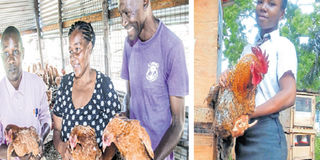Where each student keeps own chicken

Bahari Girls Principal, Prisca Mgute, agriculture teacher, Javis Yawa and an employee of the school's farm display chicken that they keep and a form four student (right) with her chicken. Each student in the school has been allocated a bird so that they take care of it. PHOTOS | LABAN WALLOGA | NMG
What you need to know:
- At the farm, the 84 students first dip their feet in a footbath before entering the poultry area, a routine they strictly follow to keep pests and diseases at bay.
- Each student has been allocated a bird so that they take care of it. If a chicken dies or becomes sick, the agriculture teacher deducts some marks from the student.
- Agriculture is now crucial for self-employment. I have taught it for the past 20 years in different secondary schools and I can say this is the only way to develop interest in students
- Kilifi county chief agriculture officer Fredrick Kaingu says it is easy for schools to generate income through selling milk, eggs and meat.
When the bell rings at 6.30am at Bahari Girls High School in Kilifi County, Form Four students taking agriculture normally rush to the farm to check on their poultry project.
At the farm, the 84 students first dip their feet in a footbath before entering the poultry area, a routine they strictly follow to keep pests and diseases at bay.
“If you don’t disinfect your feet, you risk introducing diseases. Chicken houses, feeding and watering troughs must remain clean,” says Mwanamwinyi Mwinyihaji, a student. The school has two separate chicken coops, one for the students with 84 birds and another for the school with 247.
For the students’ project, each chicken is kept in a separate cage, with the student’s index number inscribed on it.
The project that started last year cost over Sh60,000, according to principal Prisca Mgute.
“Each student has been allocated a bird so that they take care of it. If a chicken dies or becomes sick, the agriculture teacher deducts some marks from the student,” Mgute says, adding the school has, however, employed a farm hand to help in taking care of the birds.
However, he is not allowed to take care of the students’ poultry. “We want the learners to be fully responsible for their birds as they learn.”
The students keep Kenbro breed while the other birds are layers.
“We opted for Kenbro for the students because they are hardy. Some of the layers have started offering eggs and we hope to stop buying the produce since the students eat once a week during breakfast,” Mgute insists. Javis Yawa, the agriculture teacher, says students’ interest in farming has grown due to the project.
GENERATE INCOME
“Agriculture is now crucial for self-employment. I have taught it for the past 20 years in different secondary schools and I can say this is the only way to develop interest in students,” says Yawa, adding the birds are offered omena, maize chaff, vegetables and chick mash for younger ones.
He notes that Form Four students consume the birds during the KCSE exams period. “We treat them with chicken meal. I grew up on a farm where we kept poultry. I introduced this project in my previous station and we used to sell eggs,” he adds.
The school, which has a population of 900 students, also keeps 12 dairy cattle on the two acres where they farm.
Mgute says they get 40 litres of milk every day from four lactating cows, which students and teachers consume. They sell the produce to teachers especially when students are on half-term or on holiday.
“The animals are different crosses of Friesian and Jersey. We are no longer buying milk to make students’ tea. We also farm vegetables like collard greens and amaranth but on small quantities,” adds Mgute.
Their challenge is lack of enough water for farming activities during dry spell.
Kilifi county chief agriculture officer Fredrick Kaingu says it is easy for schools to generate income through selling milk, eggs and meat.
“Students also get nutritional value through the projects by taking milk tea, eggs and meat,” Kaingi says, adding East Coast Fever is one of the most rampant disease in the region.





